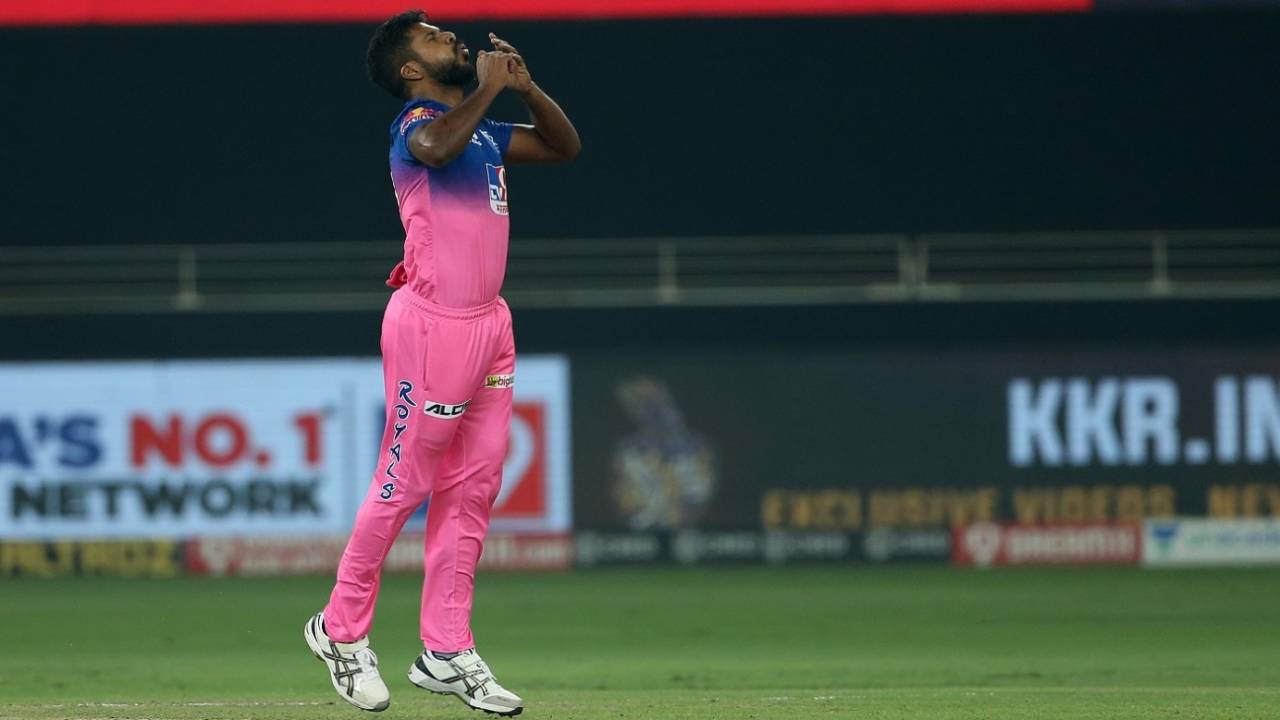0.6
Aaron to Dhawan, FOUR, Aaron fails to close a good over. Bowls a slower ball half-volley at 117ks. Dhawan loves it, and plays the pick-up over the leg side
15.6
Aaron to Pooran, 1 no-ball, short of a length, Pooran sets himself up for the six over square leg again, but the slower ball beats him. Oh hang on, this is a no-ball. Oh this might ruin what has been an excellent over
15.6
Aaron to Pooran, SIX, and that one inch over the line has cost Aaron has seven runs. And this is an incredible shot. This is a slower ball, just short of a length, and wide outside off, but he has managed to loft this over extra cover for a six
In a format where each ball is so vital and the margin for error so minimal, few things would be more infuriating for a bowler, and his captain, than a good over gone wrong because of a poor last ball. The inability to close out an over strongly can become a difficult thing for some bowlers, and with no bowler is this more apparent in IPL 2020 than with
Varun Aaron.
Aaron had some bad luck in the tournament, with two vital catches - of Prithvi Shaw and Chris Gayle - dropped off his bowling, but he also struggled with things which are in his control. He bowled only eight overs in the tournament, but even in this small sample size there have been two instances, mentioned above, when ESPNcricinfo's ball-by-ball commentators have recorded him failing to close out an over. In the game
against Kings XI Punjab, Aaron leaked 47 in four overs, of which 17 came from the balls he bowled after the fifth legal delivery of each over - those included two wides and a no-ball.
In all, Aaron's eight last balls from his eight overs have gone for 35 runs, including five fours and two sixes. That is an economy rate of 26.25 per six balls, and it constitutes a whopping 37% of the total runs he has conceded. Had he been bowling five-ball overs, Aaron's economy rate would have been 8.85 runs per over (six balls), compared to his tournament economy rate of 11.75. Aaron's economy rate - if it can be called that - of 4.38 runs per ball from the sixth ball of his over is easily the worst among all bowlers in this tournament. With an eight-over cut-off, the next poorest is Daniel Sams' 2.38.
A comparison with first-ball economy rates is even more interesting, for on that parameter, Aaron sits pretty in second place, conceding only five runs in eight balls - an economy rate of 0.63 per ball. Compare that to his last-ball economy rate of 4.38 per ball, and it's a ratio of 7.00, easily the highest among all bowlers.
At the other end of the scale are three overseas fast bowlers who were excellent on this count.
Josh Hazlewood has a last-ball economy rate of 3 and a ratio of 0.5, while the ratios for Lockie Ferguson and James Pattinson are 0.53 and 0.61.
For most top bowlers of the season, that ratio is much lower. For Jasprit Bumrah it is 1.29, for Jofra Archer it is 1.03. Similarly, it's around 1.00 for Rashid Khan (0.95), Yuzvendra Chahal (0.93) and Kagiso Rabada (0.90).
What if we expand the first and last-ball analysis to the first three and last three balls of an over? That will indicate which bowlers end an over worse than they start it. Increasing the cut-off to at least 15 overs bowled in the league stage, the bowler with the worst ratio of runs conceded from the second half of the over compared to the first is
James Neesham. He has averaged eight runs per over from the first three balls and 11.73 from the last three, which means the second half is nearly 1.5 times as expensive as the first. Ben Stokes is among the top five offenders on this parameter: he has an economy rate of 11.6 runs off his last three balls, compared with 8.93 in his first three.
Runs conceded is one aspect is comparing bowlers on how they perform within the two halves of an over; the other is their tendency to take wickets.
Till the end of the league stage, three bowlers took six more wickets from the last three balls of an over compared to the first three. Among them are
Ravi Bishnoi, who took only three wickets from 153 deliveries in the first half of his over, but nine from the same number of deliveries in the second half of the over. Similarly, fellow legspinner Chahal also has a difference of six, though he has taken more wickets than Bishnoi in each half.
However, it is not as if all legspinners set up batsmen in the first half and then dismiss them in the second - the T20 format doesn't usually allow such luxuries, though there might be specific match-ups where this has happened. At the other end of the scale is M Ashwin: of his ten wickets, eight came from the first three balls of an over, and only two from the last three.
It is tough to gauge patterns from the dismissal numbers, but bowling stats, grouped by each ball of an over, can help identify specific patterns for each bowler, hence offer clues to batsmen and a possible area of weakness for a bowler. Going by the data from IPL 2020, Aaron urgently needs to address the issue of closing out an over well.
All numbers till the end of the league stage of IPL 2020
S Rajesh is stats editor of ESPNcricinfo. @rajeshstats





